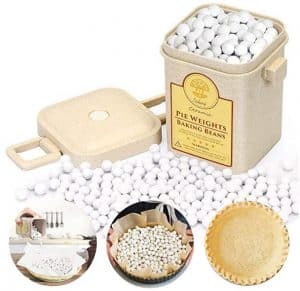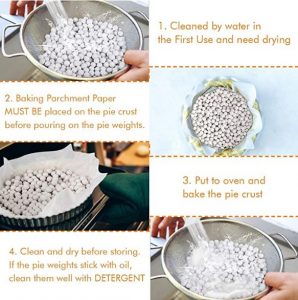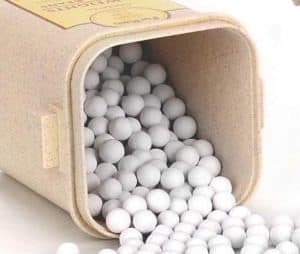When making my first pie, I didn’t know anything about pie weights, so I just made the dough and placed it in the oven, only to find some annoying air pockets and the dough looking crispy like biscuits. So I tried to find out what I did wrong, and that was when I learned about pie weights. All I needed to do was to get parchment paper and the pie weights to get my crust to form a perfect blind bake. Let’s discuss how to use ceramic pie weights.
In this article, I will share how you can use pie weights to make an amazing pie. You can hardly do without them when baking, although there are alternatives available which I will mention later in the article.
What Are Some Reasons Bakers Use Pie Weights?
Blind baking is one of the basic steps you need to take when making a pie, especially if you don’t want to end up with a soggy pie bottom. You will need pie weights baked on the pie crust to form a perfect blind bake. Pie weights are usually small in size, and you can safely use them in the oven.
They help prevent your dough from being under-baked and also avoid crust shrinkage. Pie weights also make sure that your pie does not form any air pockets that will affect the results of your pie after baking.
How to Use Ceramic Pie Weights to Blind Bake Your Crust
It is very easy to blind bake your pie crust using pie weights. You should follow these simple steps to get it done perfectly:
Prepare Your Crust
You should prepare your pie crust according to your pie recipe. Then you can place it in your pie dish and have the edges crimped depending on what you want. I prefer using a ceramic pie dish because it is non-stick.
 Line Your Pie Crust with Parchment Paper
Line Your Pie Crust with Parchment Paper
You will need either a square or circle parchment paper and line it around your pie crust. The parchment paper should still have some hanging out so it can hold the pie weights in place.
Place Your Pie Weights
You can then place your pie weights on top of the parchment paper. Make sure to fill it up entirely. If you don’t have pie weights, there are other alternatives, but I prefer using pie weights.
They are inexpensive, and you get better results. However, some people suggest using beans, loose change coins, and some other weighty oven-safe material to act as a pie weight.
Place Pie Crust in Oven
You should have your oven pre-set depending on the baking instructions of your recipe. Set the time and temperature before placing your pie crust with the pie weight in the oven. The pie crust should stay for at least 15 minutes before taking it out.
Bring Pie Crust Out of The Oven
After the set time, take out the pie crust and remove the parchment paper by lifting the overhanging part along with the pie weight. Then you can place the pie weight in a heating-proof bowl to cool down before replacing them in the container.
Return Pie Crust to Oven
After taking out the parchment paper and pie weights, you should return the pie crust to the oven to be baked again. However, you can leave it for 5 to 7 minutes to properly bake before taking it out.
Add Your Filling
When you have baked the pie crust, you should take it out of the oven and let it cool down to room temperature for about 10 to 15 minutes. When it is cool, add your filling and other ingredients to your recipe before baking your pie.
Types of Pie Weights
If you are thinking of buying pie weights, you should know that they come in different types. Most pie weights are reusable and will come in handy whenever you need to make your pie.
Ceramic Pie Weights
 The most popular choice is the ceramic weights, and I recommend it because it is safe.
The most popular choice is the ceramic weights, and I recommend it because it is safe.
Using ceramic pie weights for baking will help you get a perfect blind bake pie crust. The ceramic weights tend to store up the heat and also aid in heat transfer.
In addition, they are oven safe and can withstand high heating temperatures of up to 400°F. Ceramic is a long-lasting material, and the weight is strong enough to prevent your crust from forming air pockets or shrinking.
Pie Chain
Another type of pie weight used is the pie chain. It comes in a long string of stainless steel beads that make up the weight for your blind bake crust.
One of the perks of using pie chains is that it is easy taking them out since the stainless steel beads are joined together. Also, the stainless steel material transfers heat to the pie crust.
Aluminum Pie Weights
Aluminum pie weights like the other two mentioned help to press down the crust. It is a perfect conductor of heat and will help prevent any bubble in the crust.
Aluminum pie weights are usually very small and suitable for making small pie molds and tart. It can fill in the cracks where it would be difficult for the ceramic or pie chain to reach.
Pie Weights Substitute
There are many other substitutes for pie weights. The only problem with these methods is that you can’t reuse these substitutes after making your pie. You can use dried beans, dried rice steel ball bearings, and coins.
Final Thoughts
Making a pie may seem easy, but you shouldn’t forget to use pie weights if you want your pie crust to turn out right. I prefer ceramic pie weights because they are strong and durable. They are also safe and won’t contaminate your food.
Ceramic is oven safe and can be used under any heating temperature. It is a preferred choice for even professional chefs. The ceramic balls won’t change color; they are easy to clean and maintain. You can use it for all your pie recipes, tarts, and even quiches.
